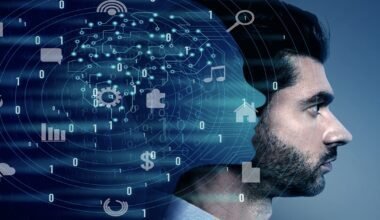Summary:- Role of Artificial Intelligence in cybersecurity is transformative, offering advanced threat detection, prediction, and real-time response. It helps organisations stay secure amidst growing digital threats and is closely linked to data science for predictive insights.
Introduction
The digital world has opened up amazing opportunities for businesses, making everything more accessible and efficient. But with the rise of digitisation comes a dark side—cyber threats! In 2022 alone, over 2,000 Indian websites were hacked, revealing just how vulnerable the internet can be.
And the financial and personal impact of these breaches is immense. Personal data is compromised, and businesses face significant financial losses.
But how can organisations keep up with these growing cybersecurity challenges? The answer lies in Artificial Intelligence (AI). The global cybersecurity market, valued at USD 190.4 billion in 2023, is projected to grow at a compound annual growth rate (CAGR) of 9.4%, reaching $298.5 billion by 2028.
As AI becomes more integrated into cybersecurity, it’s revolutionising how businesses defend against cyber threats. In this blog, we’ll explore how AI is transforming cybersecurity and why it’s the future of keeping our digital spaces safe.
Key Takeaways
- AI is revolutionising cybersecurity by detecting threats faster and more accurately.
- Integrating multiple AI systems improves cybersecurity protection and adaptability.
- AI can predict cyberattacks by identifying vulnerabilities and analysing patterns.
- Data science plays a key role in improving AI models used for cybersecurity.
- AI’s continuous learning ensures evolving protection against emerging cyber threats.
Understanding Artificial Intelligence: What Makes AI Tick?
Before diving into the specifics of AI in cybersecurity, let’s break down what Artificial Intelligence is and why it’s so useful in enhancing security.
AI involves programming machines to think, learn, and adapt like humans. It works by processing large amounts of data. Through this data, AI makes decisions, detects patterns, and improves over time. In fact, around 95% of cybersecurity breaches are caused by human error, and AI helps reduce that vulnerability by identifying potential threats faster and more accurately.
By leveraging AI, we are not only combating human error but also developing systems that can learn from every threat and adapt to better protect.
AI’s Core Programming Elements in Cybersecurity
Now, let’s dive into the main elements of AI programming that make it so effective in the world of cybersecurity:
Data Acquisition and Pre-processing
The first step in AI programming is gathering raw data from various sources, such as text files, databases, or sensors. This data is often messy and needs cleaning, which involves filling in missing values, scaling the data to a specific range, and creating new, useful features from existing ones.
Model Selection and Design
Once the data is ready, the next step is choosing the right AI model. Depending on the task (e.g., identifying cyber threats or classifying data), different models, such as decision trees or convolutional neural networks, may be used.
Training the Model
AI models learn through training. The system uses data to adjust its internal parameters until it minimises errors and starts making more accurate predictions. Validation data (data not used in training) helps the AI avoid overfitting and ensures it performs well on new, unseen data.
Deployment and Monitoring
Once the AI model is trained, it is deployed in the real world, where it continuously monitors systems for potential threats. AI models are regularly fine-tuned based on new data and emerging attack tactics.
AI: A Game Changer in Cybersecurity
With digital threats constantly evolving, traditional cybersecurity measures often fall short. This is where AI steps in, offering dynamic, real-time solutions to safeguard sensitive data. Here’s how AI is changing the cybersecurity landscape:
Understanding Network Behaviour
AI uses machine learning and deep learning to monitor and understand network behaviour. By recognising patterns and anomalies in data, AI can detect potential security issues even before they fully develop.
Handling Huge Amounts of Data
AI has the power to sift through massive amounts of data at lightning speed. It can detect threats hidden within vast networks, far beyond what a human security team could manually analyse.
Identifying Repeating Patterns
Cybercriminals often repeat their tactics. AI systems can identify these patterns, even when attackers try to change their methods. Once these tactics are recognised, AI can raise an alarm before the system is compromised.
Combining AI Forces for Maximum Cybersecurity Protection
Imagine syncing multiple AI systems together, each with its unique strength. This combination can create an all-encompassing cybersecurity shield. Here’s how integrating AI can amplify protection:
Enhanced Threat Detection
By syncing multiple AI systems, each focusing on different aspects of cybersecurity, such as malware detection or anomaly detection, we can create a more robust detection system that more efficiently captures threats.
Improved Threat Analysis
AI models working in unison can analyse complex cyberattacks from multiple angles, helping security teams understand and respond to threats faster.
Adapting to New Threats
Cybercriminals don’t rest, and neither should our defences. By connecting different AI systems, we ensure a cybersecurity system that adapts quickly to new attack methods, keeping ahead of the curve.
Reducing False Positives
AI can sometimes flag harmless events as threats, known as false positives. But when multiple AI systems flag the same issue, it’s likely a real threat. Cross-validation between AI systems reduces these false alarms.
The Benefits of AI in Cybersecurity
AI provides several significant advantages in the fight against cybercrime. Here are a few:
Detecting New Threats
Cybercriminals continuously evolve their tactics, but AI helps identify even the smallest changes in their behaviour. This early detection is key to preventing attacks before they escalate.
Bot Blocking
Bots, especially in the form of malicious automated scripts, are becoming increasingly common. AI can distinguish between legitimate and bot traffic, preventing scams from overwhelming the system.
Predicting Breaches
AI systems can monitor vulnerabilities and identify weak spots in a network, predicting where breaches might happen. By addressing these areas proactively, organisations can significantly reduce the likelihood of a cyberattack.
Endpoint Protection
Remote work and flexible office arrangements have made endpoint protection essential. AI systems monitor behaviours, locations, and time zones, detecting suspicious activities that could indicate a security breach.
How AI is Revolutionising Cybersecurity
Many leading companies, such as IBM, Google, and Juniper Networks, have already integrated AI into their cybersecurity strategies. These AI systems can predict cyber threats and learn from every attack attempt, ensuring greater protection with each iteration.
While AI steals the spotlight, it’s essential to remember that it works hand in hand with Data Science. Machine learning, a subset of artificial intelligence (AI), is closely tied to data analytics and plays a crucial role in helping AI models understand and predict threats.
As AI in cybersecurity continues to grow, there will be increasing demand for professionals skilled in both AI and data science.
Suppose you’re interested in pursuing a career in AI. In that case, data science certifications can help you understand core concepts and provide practical knowledge on using AI to address real-world cybersecurity issues.
Closing thoughts
The role of artificial intelligence in cybersecurity is undeniable, as it provides businesses with innovative ways to combat increasingly sophisticated cyber threats. By leveraging AI, organisations can anticipate and mitigate risks, ensuring the safety of their data.
As AI continues to evolve, its integration with data science becomes more important. If you’re passionate about understanding and implementing AI in cybersecurity, consider joining data science courses by Pickl.AI.
These courses can equip you with the essential knowledge and skills to thrive in this dynamic field. Stay ahead of the curve, as AI’s role in cybersecurity grows, and unlock new career opportunities in this rapidly advancing domain.
Frequently Asked Questions
How does AI help in cybersecurity?
AI enhances cybersecurity by analysing large datasets, identifying patterns, and detecting threats in real time. It significantly reduces human error and improves decision-making, allowing businesses to address potential vulnerabilities and threats before they escalate proactively.
What are the benefits of AI in cybersecurity?
AI in cybersecurity offers benefits like detecting new threats, blocking bots, predicting breaches, and providing endpoint protection. It enables faster response times, improved threat detection accuracy, and helps organisations stay ahead of evolving cyber threats.
Can AI predict future cyberattacks?
Yes, AI can predict potential cyberattacks by analysing vulnerabilities and identifying patterns in cybercriminal behaviour. AI systems can flag high-risk areas and proactively defend against breaches, minimising the likelihood of successful attacks.



